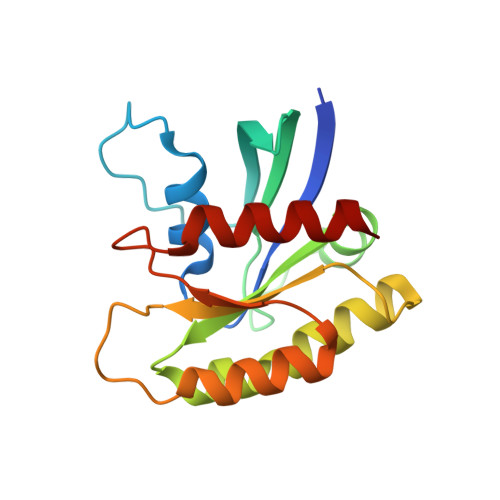Structural basis for conformational dynamics of GTP-bound Ras protein
Shima, F., Ijiri, Y., Muraoka, S., Liao, J., Ye, M., Araki, M., Matsumoto, K., Yamamoto, N., Sugimoto, T., Yoshikawa, Y., Kumasaka, T., Yamamoto, M., Tamura, A., Kataoka, T.(2010) J Biol Chem 285: 22696-22705
- PubMed: 20479006
- DOI: https://doi.org/10.1074/jbc.M110.125161
- Primary Citation of Related Structures:
3KKM, 3KKN, 3KKO, 3KKP, 3KKQ - PubMed Abstract:
Ras family small GTPases assume two interconverting conformations, "inactive" state 1 and "active" state 2, in their GTP-bound forms. Here, to clarify the mechanism of state transition, we have carried out x-ray crystal structure analyses of a series of mutant H-Ras and M-Ras in complex with guanosine 5'-(beta,gamma-imido)triphosphate (GppNHp), representing various intermediate states of the transition. Crystallization of H-RasT35S-GppNHp enables us to solve the first complete tertiary structure of H-Ras state 1 possessing two surface pockets unseen in the state 2 or H-Ras-GDP structure. Moreover, determination of the two distinct crystal structures of H-RasT35S-GppNHp, showing prominent polysterism in the switch I and switch II regions, reveals a pivotal role of the guanine nucleotide-mediated interaction between the two switch regions and its rearrangement by a nucleotide positional change in the state 2 to state 1 transition. Furthermore, the (31)P NMR spectra and crystal structures of the GppNHp-bound forms of M-Ras mutants, carrying various H-Ras-type amino acid substitutions, also reveal the existence of a surface pocket in state 1 and support a similar mechanism based on the nucleotide-mediated interaction and its rearrangement in the state 1 to state 2 transition. Intriguingly, the conformational changes accompanying the state transition mimic those that occurred upon GDP/GTP exchange, indicating a common mechanistic basis inherent in the high flexibility of the switch regions. Collectively, these results clarify the structural features distinguishing the two states and provide new insights into the molecular basis for the state transition of Ras protein.
Organizational Affiliation:
Division of Molecular Biology, Department of Biochemistry and Molecular Biology, Kobe University Graduate School of Medicine, 7-5-1 Kusunoki-cho, Chuo-ku, Kobe 650-0017, Japan.
















